Colin's Journal: A place for thoughts about politics, software, and daily life.
August 29th, 2004
Fedora hardware support
This post is about computers, so if that bores you click on the pretty picture instead of reading on!
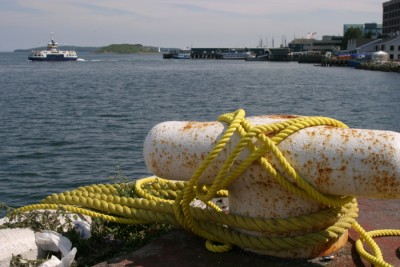 When adding new hardware to a machine running Linux it will either work straight away, or it will be a challenge to your patience. For example if you add a new Ethernet card to your machine there’s a very good chance that on rebooting it will be found and will work with no extra software being required.
When adding new hardware to a machine running Linux it will either work straight away, or it will be a challenge to your patience. For example if you add a new Ethernet card to your machine there’s a very good chance that on rebooting it will be found and will work with no extra software being required.
When hardware isn’t fully supported however things become complex and trying. Take for example the Epson Perfection 2480 scanner that we purchased yesterday. I had already researched Linux support, and found that neither the official Epson software for Linux (iScan), nor SANE support it. Just this week, however, on the development mailing list for SANE there was a thread about this scanner, and a couple of patches that enabled support for it.
To get the Epson Perfection 2480 scanner working I had to:
- Download the latest development source code for SANE from CVS.
- Apply the patches described in these two posts.
- Build the modified source, and install.
- Find the scanner firmware (Esfw41.bin) from the Epson CD. To do this I had to install cabextract, and then unarchive the file ESCAN/ModUsd.cab from the CD.
- Edit the /usr/local/etc/sane.d/snapscan.conf file to set the location of the firmware file.
- Add the line “usb 0x04b8 0x0121” to the /usr/local/etc/sane.d/snapscan.conf file.
- Install the SANE hotplug scripts from the tools directory.
- Create a new group called “scanner”, and add myself to this group.
- Download the latest XSANE front-end, build from source and install.
- Logout and log back in again so that adding myself to the scanner group would take effect.
After all this the scanner now works.
August 23rd, 2004
Photo trawl
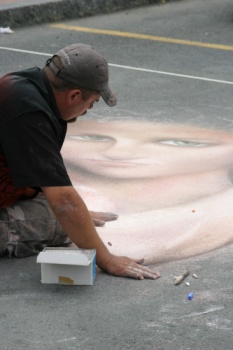 The downside to taking lots of photographs is having to trawl through them afterwards to find the good ones. Doing this is a mixed blessing. On the one hand finding an good, and more rarely a captivating photo, is a great reward. On the other hand looking at so many photos that just don’t work is frustrating. On seeing a photo I have questions running through my mind: what was I trying to capture? Why did I expose it like that? Why couldn’t I get rid of that extraneous object from the frame?
The downside to taking lots of photographs is having to trawl through them afterwards to find the good ones. Doing this is a mixed blessing. On the one hand finding an good, and more rarely a captivating photo, is a great reward. On the other hand looking at so many photos that just don’t work is frustrating. On seeing a photo I have questions running through my mind: what was I trying to capture? Why did I expose it like that? Why couldn’t I get rid of that extraneous object from the frame?
Until I’ve worked my way through the Halifax, Peggy’s Cove, and Lunnenburg photos I will not have anything to illustrate the next stage of our holiday. Once I have been through the remaining photos I should be able to write some more about our brief trip around central Nova Scotia. I may, time and motivation permitting, even get around to creating a proper album for the trip.
[Photo is of Dave Johnston the Chalkmaster working during the Halifax busker festival]
August 17th, 2004
Halifax to Lunenburg
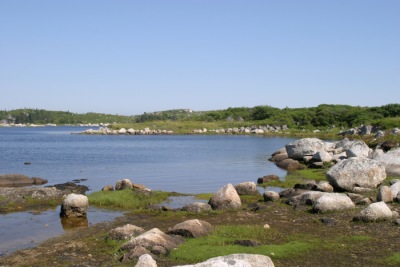 Over the last two weeks I’ve been travelling around central Nova Scotia. The last post I made described Halifax, and the only two days of poor weather that we encountered on this trip. On leaving Halifax we drove west along the coast en-route to Lunenburg.
Over the last two weeks I’ve been travelling around central Nova Scotia. The last post I made described Halifax, and the only two days of poor weather that we encountered on this trip. On leaving Halifax we drove west along the coast en-route to Lunenburg.
The coastal road quickly led away from the heavily forested Halifax area into exposed moorland. Trees become rarer, interspersed by large areas of grass, shallow lakes and glacial boulders. It is a magical environment to drive through as the road weaves between lakes and boulders grace the horizon in all directions. I would need at least three photos to capture the feel of the place, but the first one in this post gives some idea of what it is like.
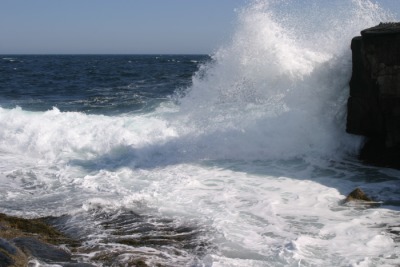 Although Peggy’s Cove is a heavily visited destination I’m very glad that we joined the crowds. The main attraction is meant to be the lighthouse, but I didn’t find that particular inspiring. We parked in the tourist information car park on the edge of the hamlet, rather than at the lighthouse. This was a good choice on our part as it allowed us to wander through the almost deserted marshy ferns and grasses towards the ocean.
Although Peggy’s Cove is a heavily visited destination I’m very glad that we joined the crowds. The main attraction is meant to be the lighthouse, but I didn’t find that particular inspiring. We parked in the tourist information car park on the edge of the hamlet, rather than at the lighthouse. This was a good choice on our part as it allowed us to wander through the almost deserted marshy ferns and grasses towards the ocean.
Despite it being a very pleasant day the wind coming in at Peggy’s Cove was fairly strong. Medium sized waves crashed enthusiastically against the shoreline sending spray many meters into the air. It was easy to gain a respect for the power of the waves coming in, especially on such a relatively calm day.
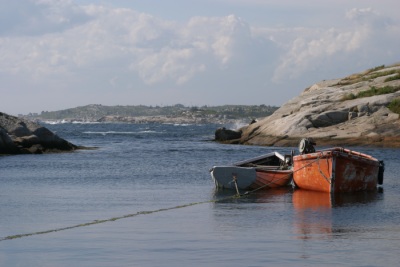 Only after seeing the rough seas crashing against an unforgiving coastline could I appreciate the small harbour at Peggy’s Cove. The harbour is naturally sheltered in an amazing contrast to the area immediately surrounding it. The water is as calm as a small lake, with a handful of dinghy’s moored alongside the odd fishing vessel.
Only after seeing the rough seas crashing against an unforgiving coastline could I appreciate the small harbour at Peggy’s Cove. The harbour is naturally sheltered in an amazing contrast to the area immediately surrounding it. The water is as calm as a small lake, with a handful of dinghy’s moored alongside the odd fishing vessel.
After Peggy’s Cover we continued on the coastal road all the way to Lunenburg, passing through numerous small towns and villages on the way. Although many were photogenic places we didn’t have time to stop and wander around, and so could only admire them in passing.
My apologies to those reading this over a dialup link – I’ve tried to keep the in-line pictures small, but this post is still going to take a while to load.
August 7th, 2004
Halifax in the rain
 The waterfront of Halifax is almost dedicated to tourists. There are a selection of restaurants, pavilions, and tacky gift shops interwoven around a wooden boardwalk. Mooring space appears plentiful, and at least this week, very underused.
The waterfront of Halifax is almost dedicated to tourists. There are a selection of restaurants, pavilions, and tacky gift shops interwoven around a wooden boardwalk. Mooring space appears plentiful, and at least this week, very underused.
My impression is that most visitors to Halifax do not stay more than a couple of days. This weeks entertainment is in the form of a busker festival, which features a slow rotation of artists who continue to draw significant crowds despite repeating the same set multiple times per day.
When we arrived here the weather was warm at around 27C, yet with a pleasant breeze and a few clouds to provide occasional shade. Yesterday however it turned for the worse, with showers all day long. Today is no better, which means that the whale watching I had planned for today will not be taking place.
Yesterday I spent some time in the Natural History Museum. The museum features a small section on geology and dinosaurs, but is mostly dedicated to the history and wildlife of Nova Scotia. The history exhibit on Nova Scotia starts well enough, but then skips several thousand years of history with no explanation. The focus on local wildlife however was very successfully put together. The mini-exhibit on Sable Island was interesting, but limited in the amount of information included.
Following the trip to the museum I wandered into a local park to take some pictures in the rain. A few of the flower pictures came out fairly well, and I expect that I’ll end up taking similar photos today.
Software
The full list of my published Software
Email: colin at owlfish.com
